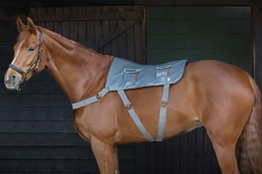SERVICES
Equilibrium Massage Pad £25 p/w
https://www.equilibriumproducts.com/product/equilibrium-therapy-massage-pad/
-
General back pain

Photizo Vetcare LED £30 p/w
https://www.danetrehealthproducts.com/product/photizo-vetcare/
-
Manages certain conditions between physio appointments
-
Useful between physio appointments/ laser therapy
-
Improves scar appearance
-
Assists wound healing
-
Improves circulation
-
Reduces local pain


Equiband System £15 p/w
http://equicoreconcepts.com/system/
-
Promotion of correct self-carriage & stability
-
Kissing spine rehabilitation
-
Strength & conditioning
Available in Herts, Beds, Bucks
Call or txt Lynne to discuss 07527898784
During a physiotherapy treatment
Sessions generally last around one hour. A dynamic and static assessment is followed by appropriate methods to reduce pain and improve your animals way of going. Techniques include manual therapies including joint mobilisation, chiropractic adjustment and massage and electrotherapies such as laser therapy and therapeutic ultrasound.
Taken from http://www.electrotherapy.org/modality/laser-therapy
LLLT when applied to the body tissues, delivers energy at a level sufficient to disturb local electron orbits & result in the generation of heat, initiate chemical change, disrupt molecular bonds & produce free radicals. These are considered to be the primary mechanisms by which LLLT achieves its physiological & therefore therapeutic effects and the primary target is effectively the cell membrane.
Inflammatory Arthropathies
There have been several trials involving the use of LILT and various inflammatory problems in joints. As with the wound work, there are mixed results, but the general trend appears to be largely supportive. The recent Ottawa Panel review was supportive of laser therapy in RA.
Soft Tissue Injury
There is a fairly widespread use of LILT in a variety of soft tissue treatments. Some results are excellent and others poor. It is possible that the weak results relate to incorrect doses or possibly considering the use of laser therapy for injuries that are simply beyond the reach of the energy delivered (see penetration section above). The Tuner and Hode book has multiple examples of effective (and less effective) soft tissue treatments with LILT and identifies some of the key research in this area.
Pain
It was broadly assumed (until more recently) that the effect of laser therapy with regards to pain relief was primarily a secondary effect of dealing with the inflammatory state. Whilst this may well be true (to some extent at least), there is growing evidence that laser therapy can have a more direct effect of nerve conduction characteristics and hence may result in reduced pain as a more direct effect of the therapy. A recent example of a paper along these lines would be Vinck et al 2005.
Therapeutic Ultrasound
Laser Therapy
Taken from http://www.electrotherapy.org/modality/ultrasound-therapy
Ultrasound is a form of mechanical energy. Tissue particles, when exposed to a sound wave will oscillate about a fixed point. Any increase in the molecular vibration in the tissue can result in heat generation, and ultrasound can be used to produce thermal changes in the tissues, though current usage in therapy does not focus on this phenomenon (Williams 1987, Baker et al 2001, ter Haar 1999, Nussbaum 1997, Watson 2000, 2008). One of the therapeutic effects for which ultrasound has been used is in relation to tissue healing. It is suggested that the application of US to injured tissues will, amongst other things, speed the rate of healing & enhance the quality of the repair (Watson 2006).
Thermal
In thermal mode, ultrasound will be most effective in heating dense collagenous tissues . Among the more effectively heated tissues are periosteum, collagenous tissues (ligament, tendon & fascia) & fibrotic muscle (Dyson 1981). If the temperature of the damaged tissues is raised to 40‑45°C, then a hyperaemia will result, the effect of which will be therapeutic. In addition, temperatures in this range are also thought to help in initiating the resolution of chronic inflammatory states (Dyson & Suckling 1978).
Non-Thermal
The non-thermal effects of US are now attributed primarily to a combination of cavitation and acoustic streaming (ter Haar 1999, 2008 Baker et al 2001, Williams 1987).
The best absorbing tissues in terms of clinical practice are those with high collagen content – ligament, tendon, fascia, joint capsule scar tissue (Watson 2000, 2008, Watson & Young, 2008, ter Haar 1999, Nussbaum 1998, Frizzel & Dunn 1982
Treatment will be applied via a suitable coupling medium (ultrasound gel).


